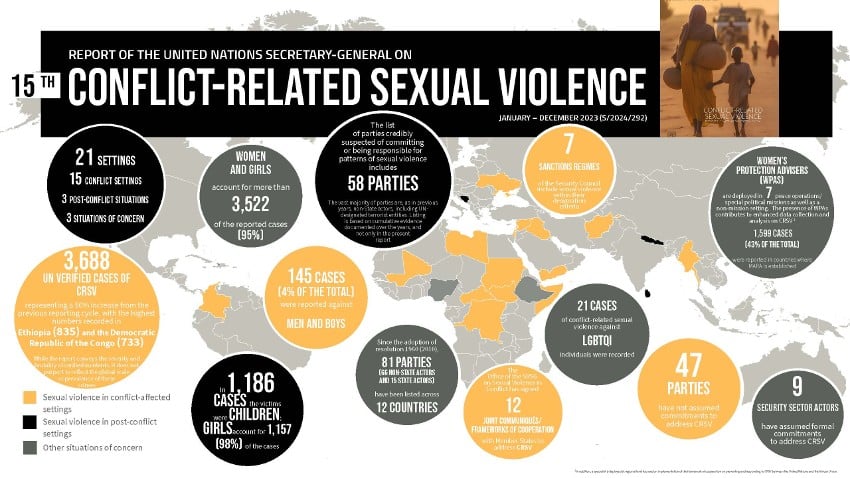“The world is facing the highest number of conflicts since World War II” from Ukraine to Sudan to Gaza and Afghanistan, where sexual violence continues to be used as a weapon of war. The latest UN Secretary-General report on Conflict-related Sexual Violence highlights new, alarming trends regarding conflict-related sexual violence and demands urgent action.
“Conflict-related sexual violence is a devastating form of attack and repression, which has lasting, harmful effects on survivors’ physical, sexual, reproductive, and mental health, and destroys the social fabric of communities,” says UN Secretary-General António Guterres on the occasion of this year’s International Day for the Elimination of Sexual Violence in Conflict.
According to the report, “disregard for international law, arms proliferation, increasing militarization, and shrinking civic space” continue to exacerbate conflict-related sexual violence, hindering safe reporting and response.
Women and girls are disproportionately affected by conflict-related sexual violence, accounting for more than 95% of the total 3,622 UN-verified cases reported cases. In 1,186 cases of sexual violence, the victims were children, with girls accounting for 1,157 (98%) of the victims. However, sexual violence in conflicts is also perpetrated against men and boys, who account for 145 cases (4%), according to the data. In addition, 21 of the cases were committed against LGBTIQ+ individuals.
The report goes on to define the term conflict-related sexual violence as “rape, sexual slavery, forced prostitution, forced pregnancy, forced abortion, enforced sterilization, forced marriage, and any other form of sexual violence of comparable gravity perpetrated against women, men, girls or boys,” directly or indirectly linked to a conflict. The term also refers to sexual trafficking and/or exploitation “when committed in situations of armed conflict”.
UN data makes clear that survivors of conflict-related sexual violence do not belong to a single homogenous group; therefore, “an intersectional analysis and tailored, survivor-centred approaches to address their needs” are crucial.
Moreover, “sexual violence curtailed women’s livelihoods and girls’ access to education while generating profits for armed and violent extremist groups”, including through conflict-driven human trafficking for sexual exploitation.
This year’s International Day for the Elimination of Sexual Violence in Conflict focuses on the importance of healthcare. As stated by the Secretary-General, “Hospitals and other healthcare facilities should be beacons of safety and healing for all those injured in conflict, including survivors of sexual violence.” Women and girls who experience sexual violence may become pregnant as a result of rape, needing immediate sexual and reproductive healthcare. Men and boys “may risk increased isolation if they cannot access appropriate care.”
But, “the massive and widespread destruction of health facilities, the direct and indirect killing of health workers and humanitarian access constraints” severely hinder the provision of life-saving medical assistance for survivors of conflict-related sexual violence, “who require comprehensive medical care, post-exposure prophylaxis, sexual and reproductive healthcare, psychosocial support, as well as avenues for reporting.”
On this International Day for the Elimination of Sexual Violence in Conflict, UN Secretary-General António Guterres urges the international community to pledge “to eliminate this scourge, stand in solidarity with survivors, and reaffirm our commitment to protecting hospitals and healthcare facilities during conflict.”
Additional links:


